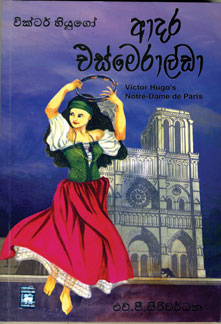Celebrated French classic in Sinhala
Reviewed by Edwin Ariyadasa
In the current social context, gratitude is a fast eroding human
virtue. Today, a harsh cynicism seems to sweep right across humanity, at
the relentless speed of a pandemic.
 People in general, do not seem to be stirred by a need to be
grateful, even when that sentiment is strongly called for. People in general, do not seem to be stirred by a need to be
grateful, even when that sentiment is strongly called for.
In such a distressing background, the gesture of the exemplary
person, who is behind this publication under review, has to be recorded
with an inescapable sense of duty.
The outstanding person in question is Nihal Sarathchandra Akmeemana,
a diasporic Sri Lankan residing in Auckland, New Zealand. He brought out
the present edition of this book, moved by a profound sense of gratitude
towards the writer the late H.P. Siriwardene Akmeemana invested his
time, effort and his resources lavishly to redeem his pledge to the late
H.P. Siriwardene, that he will bring out the third edition of this work.
And what is this book and what kind of individual is this author H.P.
Siriwardene?
Battle
The book we focus upon here, is the Sinhala version of Victor Hugo's
perennial classic Notre-Dame de Paris better known as "The Hunchback of
Notre-Dame".
Writer H.P. Siriwardene's creative abridgement of this work in
Sinhala, came out first in 1946, under the title Kudage Sangramaya (The
battle of the Hunchback.
Publication
After sixty-five long years, Nihal Akmeemana has staged-managed the
publication of its third edition, giving it the enticing title Aadara
Esmeralda (The Darling Esmeralda ). The publication is at once, Nihal
Akmeemana's tribute to the writer and his token of appreciation and
admiration of the author H.P. Siriwardene.
The name H.P. Siriwardene, may have an exotic ring, to the younger
generation of literary enthusiasts of Sri Lanka.
But in this day H.P. Siriwardene was a somewhat high-profile social
and literary presence. He received his early education, under the
guidance of Philosopher and sage Dr. E.W. Adikaram. Equally efficient
both in sports and academic pursuits, Hettimulle Appuhamilage Piyadasa
Siriwardene, evolved eventually into the Chief Editor of the Senate
Hansard. He introduced an innovated system of Sinhala shorthand which
was named after him.
H.P. Siriwardene's, literary works, were distinguished by a freshness
of outlook. His works of fiction exuded a vast sense of human kindness.
Nihal Akmeemana, who was in communication with him, in the final
stages of H.P. Siriwardene's life, was overwhelmed by the depth of H.P.
Siriwardene's compassionate wisdom. In a preamble to the present
publication, Nihal Akmeemana, provides an intriguing insight into the
mind-set of this unusual genius. When he addressed the daunting
challenge of creatively condensing Victor Hugo's classic in Sinhala,
H.P. Siriwardene was a youth of 29.
Way back in 1946, the landscape of Sri Lankan literature, did not
possess even a vestige of the proliferation of Sinhala translations we
witness today. This implied that H.P. Siriwardene had to embark upon his
own exhilarating voyage of discovery.
Quality
To judge from the quality of his work H.P.S. had fully fathomed the
essence of an efficient translation, which in effect, is a matter of
transmitting one culture into another. A given word or an expression in
any language, is a verbal icon of the way of life of the people who
speak and write that language.
An authentic translation is not merely an exercise in substituting
words and expressions. The translated version should communicate not
only the literary meaning of the words and expressions of the original,
but must convey the "ethos" of the original as well. The translator must
obtain an insight into the mind of the original writer.
Epic mind
And, in adapting Victor Hugo to Sinhala, what an epic mind did H.P.S.
had to confront? Victor Hugo was a genious with a universal horizon. He
had reached the highest peaks of literary excellence and was part of the
Movement of Romanticism.
|

